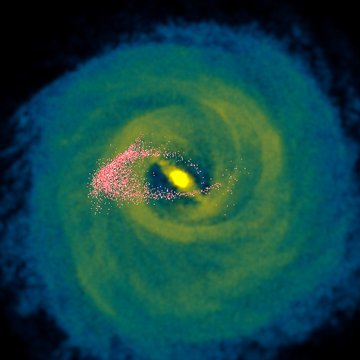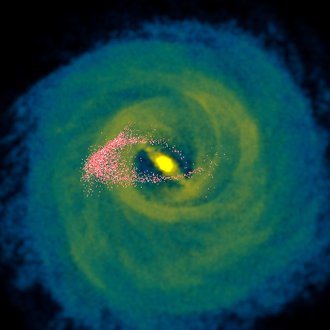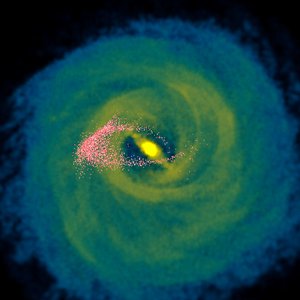A small snack for the Milky Way
Astrophysicists find new remnants of a neighbouring galaxy in our own galaxy.
An international team of astronomers led by Mary Williams from the Astrophysical Institute Potsdam (AIP) has discovered a new stream of stars in our Milky Way: the “Aquarius Stream”, named after the constellation of Aquarius. The stream of stars is a remnant of a smaller galaxy in our cosmic neighbourhood, which has been pulled apart by the gravitational pull of the Milky Way about 700 million years ago. The discovery is a result of the measurement of the velocities of 250,000 stars with the RAVE Survey based at the Australian Astronomical Observatory's UK Schmidt Telescope at Siding Spring Observatory, NSW, Australia.
"I have a stream“: with these words the 33-year old scientist from New Zealand enthusiastically presented her discovery to the audience of an international conference. The Aquarius stream was indeed hard to find. Contrary to practically all known streams of stars it is located within the galactic disk. Within the disk, the high concentration of stars of the Milky Way are blocking our way and the stream is indistinguishable from the rest of the stars in its shape. “It was right on our doorstep” Williams says, “but we just couldn’t see it.”
Using RAVE data, the astronomer has now measured the radial velocity of 12,000 stars in that region for the first time. In this way she found that 15 stars show a different velocity pattern than the others, moving at relative speeds of up to 720,000 km/h through the rotating disk of the Milky Way. The comparison of the star parameters with simulations showed that those stars form part of a larger stream of stars originating from a smaller neighbouring galaxy which was attracted by the Milky Way. This galaxy finally met the Milky Way and was pulled apart by it about 700 million of years ago, when the stream of stars formed dynamically. This makes the Aquarius stream a special and exceptionally young stream. Other known streams of stars are billions of years old and they are located in the outskirts of our galaxy.
Considering the special method of the RAVE survey which has led to the discovery of this stream, astronomers are optimistic to see many more discoveries of this kind in the future. RAVE is planned to measure the characteristics of up to a million of stars of our Milky Way until 2012. Williams has been part of the project from the very start and is managing the data processing at AIP since 2007.
"With RAVE, we want to understand the formation history of our Milky Way”, Matthias Steinmetz, project leader of the multinational RAVE collaboration at the Astrophysical Institute Potsdam explains. “We want to find out how frequent those merging events with neighbouring galaxies have happened in the past and how many we are to expect in the future.”
What is certain: in about three billion years the Milky Way will see its next huge collision with the Andromeda galaxy – if none of the dwarf galaxies which have been discovered during the past years in our direct cosmic neighbourhood arrives first.
RAVE is a multinational project with participation of scientists from Australia, Germany, France, UK, Italy, Canada, the Netherlands, Switzerland, Slovenia and the USA. Funding of RAVE which guarantees extensive data, telescope and instrument access is provided by the national research foundations.
Further information
Williams et al., Astrophysical Journal, Issue 728-2, 2011.
Astrophysicists find new remnants of a neighbouring galaxy in our own galaxy.
An international team of astronomers led by Mary Williams from the Astrophysical Institute Potsdam (AIP) has discovered a new stream of stars in our Milky Way: the “Aquarius Stream”, named after the constellation of Aquarius. The stream of stars is a remnant of a smaller galaxy in our cosmic neighbourhood, which has been pulled apart by the gravitational pull of the Milky Way about 700 million years ago. The discovery is a result of the measurement of the velocities of 250,000 stars with the RAVE Survey based at the Australian Astronomical Observatory's UK Schmidt Telescope at Siding Spring Observatory, NSW, Australia.
"I have a stream“: with these words the 33-year old scientist from New Zealand enthusiastically presented her discovery to the audience of an international conference. The Aquarius stream was indeed hard to find. Contrary to practically all known streams of stars it is located within the galactic disk. Within the disk, the high concentration of stars of the Milky Way are blocking our way and the stream is indistinguishable from the rest of the stars in its shape. “It was right on our doorstep” Williams says, “but we just couldn’t see it.”
Using RAVE data, the astronomer has now measured the radial velocity of 12,000 stars in that region for the first time. In this way she found that 15 stars show a different velocity pattern than the others, moving at relative speeds of up to 720,000 km/h through the rotating disk of the Milky Way. The comparison of the star parameters with simulations showed that those stars form part of a larger stream of stars originating from a smaller neighbouring galaxy which was attracted by the Milky Way. This galaxy finally met the Milky Way and was pulled apart by it about 700 million of years ago, when the stream of stars formed dynamically. This makes the Aquarius stream a special and exceptionally young stream. Other known streams of stars are billions of years old and they are located in the outskirts of our galaxy.
Considering the special method of the RAVE survey which has led to the discovery of this stream, astronomers are optimistic to see many more discoveries of this kind in the future. RAVE is planned to measure the characteristics of up to a million of stars of our Milky Way until 2012. Williams has been part of the project from the very start and is managing the data processing at AIP since 2007.
"With RAVE, we want to understand the formation history of our Milky Way”, Matthias Steinmetz, project leader of the multinational RAVE collaboration at the Astrophysical Institute Potsdam explains. “We want to find out how frequent those merging events with neighbouring galaxies have happened in the past and how many we are to expect in the future.”
What is certain: in about three billion years the Milky Way will see its next huge collision with the Andromeda galaxy – if none of the dwarf galaxies which have been discovered during the past years in our direct cosmic neighbourhood arrives first.
RAVE is a multinational project with participation of scientists from Australia, Germany, France, UK, Italy, Canada, the Netherlands, Switzerland, Slovenia and the USA. Funding of RAVE which guarantees extensive data, telescope and instrument access is provided by the national research foundations.
Further information
Williams et al., Astrophysical Journal, Issue 728-2, 2011.
Images
Visualization of the Aquarius stream and its location in the Milky Way.





